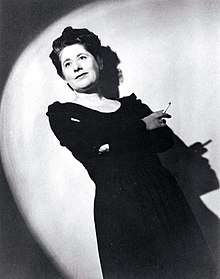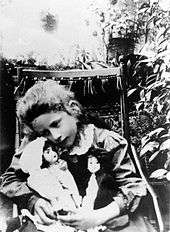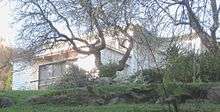Ngaio Marsh
Dame Ngaio Marsh DBE (/ˈnaɪ.oʊ/; 23 April 1895 – 18 February 1982), born Edith Ngaio Marsh, was a New Zealand crime writer and theatre director. She was appointed a Dame Commander of the Order of the British Empire in 1966.[1]
Dame Ngaio Marsh DBE | |
|---|---|
 Ngaio Marsh, 1940s | |
| Born | Edith Ngaio Marsh 23 April 1895 Christchurch, New Zealand |
| Died | 18 February 1982 (aged 86) Christchurch, New Zealand |
| Occupation | Writer, theatre director |
| Language | English |
| Education | St Margaret's College, Christchurch |
| Alma mater | University of Canterbury |
| Genre | Crime fiction |
| Literary movement | Golden Age of Detective Fiction |
| Relatives | Robert Speight (uncle) |
Marsh is known as one of the "Queens of Crime", along with Agatha Christie, Dorothy L. Sayers, and Margery Allingham. She is known primarily for her character Inspector Roderick Alleyn, a gentleman detective who works for the Metropolitan Police (London).
The Ngaio Marsh Award is awarded annually for the best New Zealand mystery, crime and thriller fiction writing.[1]
Youth


Marsh was born in the city of Christchurch, New Zealand, where she also died. The origin of the name "Ngaio" is a Maori word which is the name of a flowering tree and also the name of an insect found in New Zealand. Her father neglected to register her birth until 1900 and there is some uncertainty about the date.[2] She was the only child of Rose and bank clerk Henry Marsh, described by Marsh as "have-nots".[3] Her mother's sister Ruth married the geologist, lecturer, and curator Robert Speight.[4] Ngaio Marsh was educated at St Margaret's College in Christchurch, where she was one of the first students when the school was founded. She studied painting at the Canterbury College (NZ) School of Art before joining the Allan Wilkie company as an actress in 1916 and touring New Zealand.[1] For a short time in 1921 she joined the Rosemary Rees English Comedy Company, a touring company formed by actor-manager Rosemary Rees.[5] From 1928 she divided her time between living in New Zealand and the United Kingdom.[6] From 1928 to 1932 she operated an interior decorating business in Knightsbridge, London.[7]
Marsh was a member of The Group, an art association based in Christchurch, New Zealand. She exhibited with them in 1927; 1928; 1935; 1936; 1938; 1940; 1947.[8][9]
Career
Internationally she is best known for her 32 detective novels published between 1934 and 1982. Along with Dorothy L. Sayers, Margery Allingham and Agatha Christie, she has been classed as one of the four original "Queens of Crime" — female writers who dominated the genre of crime fiction in the Golden Age of the 1920s and 1930s.[1]
All her novels feature British CID detective Roderick Alleyn. Several novels feature Marsh's other loves, the theatre and painting. A number are set around theatrical productions (Enter a Murderer, Vintage Murder, Overture to Death, Opening Night, Death at the Dolphin, and Light Thickens), and three others are about actors off stage (Colour Scheme, False Scent and Final Curtain). Her short story "'I Can Find My Way Out" is also set around a theatrical production and is the earlier "Jupiter case" referred to in Opening Night. Alleyn marries a painter, Agatha Troy, whom he meets during an investigation (Artists in Crime), and who features in three later novels.[1]
Most of the novels are set in England, but four are set in New Zealand, with Alleyn either on secondment to the New Zealand police (Colour Scheme, and Died in the Wool), or on holiday (Vintage Murder and Photo Finish); Surfeit of Lampreys begins in New Zealand but continues in London.
In 2018, HarperCollins Publishers released Money in the Morgue by Ngaio Marsh and Stella Duffy.[10] The book was started by Marsh during World War II but abandoned. Working with just the book's title, first three chapters and some notes—but no idea of the plot or motive of the villain—Duffy completed the novel.[11]
Theatre
Marsh's great passion was the theatre.[1] In 1942 she produced a modern-dress Hamlet for the Canterbury University College Drama Society (now University of Canterbury Dramatic Society Incorporated or Dramasoc[12]), the first of many Shakespearean productions with the society until 1969. In 1944, Hamlet and a production of Othello toured a theatre-starved New Zealand to rapturous acclaim. In 1949, assisted by entrepreneur Dan O'Connor, her student players toured Australia with a new version of Othello and Pirandello's Six Characters in Search of an Author. In the 1950s she was involved with the New Zealand Players, a relatively short-lived national professional touring repertory company. In 1972 she was invited by the Christchurch City Council to direct Shakespeare's Henry V, the inaugural production for the opening of the newly constructed James Hay Theatre in Christchurch; she made the unusual choice of casting two male leads, who alternated on different nights.
She lived to see New Zealand set up with a viable professional theatre industry with realistic Arts Council support, with many of her protégés to the forefront. The 430-seat Ngaio Marsh Theatre at the University of Canterbury is named in her honour.[13]
Museum

Her home in Cashmere, a suburb of Christchurch, on the northern slopes of the Port Hills is preserved as a museum.[14]
Awards and honours
- 1948: OBE for services to NZ theatre[15]
- 1962: honorary doctorate by the University of Canterbury[15][16]
- 1966: Dame Commander of the Order of the British Empire for her contribution to theatre in New Zealand[15][16]
- 1978: Grand Master Award for lifetime achievement as a detective novelist from the Mystery Writers of America[1][17]
- 2015: Marsh was honoured on 23 April 2015 with a Google Doodle[17]
Personal life
Marsh never married and had no children.[1] She enjoyed close companionships with women, including her lifelong friend Sylvia Fox, but denied being lesbian, according to biographer Joanne Drayton.[3] "I think Ngaio Marsh wanted the freedom of being who she was in a world, especially in a New Zealand that was still very conformist in its judgments of what constituted 'decent jokers, good Sheilas, and 'weirdos'", Roy Vaughan wrote after meeting her on a P&O Liner.[18] In 1965 she published an autobiography, Black Beech and Honeydew. British author and publisher Margaret Lewis wrote an authorized biography, Ngaio Marsh, A Life in 1991. New Zealand art historian Joanne Drayton's biography, Ngaio Marsh: Her Life in Crime was published in 2008. Towards the end of her life she systematically destroyed many of her papers, letters, documents and handwritten manuscripts.[1]
Having previously been awarded an OBE, she was made a Dame Commander of the Order of the British Empire in 1966, for "distinguished services in the arts, especially writing and theatre production".[19]
She died in Christchurch, and was buried at the Church of the Holy Innocents, Mount Peel.[7]
Bibliography
Detective novels
All 32 novels feature Chief Inspector Alleyn (later Chief Superintendent) of the Criminal Investigation Department, Metropolitan Police (London). The series is chronological: published and probably written in order of the fictional history.[20]
- A Man Lay Dead (1934)
- Enter a Murderer (1935)
- The Nursing Home Murder (1935)
- Death in Ecstasy (1936)
- Vintage Murder (1937). Marsh's working title was The Case of the Greenstone Tiki (Otago Daily Times, 13 March 1937)[21]
- Artists in Crime (1938)
- Death in a White Tie (1938)
- Overture to Death (1939)
- Death at the Bar (1940)
- Surfeit of Lampreys (1941); Death of a Peer in the U.S.
- Death and the Dancing Footman (1942)
- Colour Scheme (1943)
- Died in the Wool (1945). Serialised: Wagga Wagga Daily Advertiser (1946)
- Money in the Morgue (2018) (unfinished – completed by Stella Duffy)
- Final Curtain (1947)
- Swing Brother Swing (1949); A Wreath for Rivera in the U.S.. Serialised: Home Magazine (1949)
- Opening Night (1951); Night at the Vulcan in the U.S. Serialised: Woman's Day (1951)
- Spinsters in Jeopardy (1954); abridged later in the U.S. as The Bride of Death (1955)
- Scales of Justice (1955). Serialised: Australian Women's Weekly (1956)
- Off With His Head (1957); Death of a Fool in the U.S.
- Singing in the Shrouds (1959). Serialised: Australian Women's Weekly (1959)
- False Scent (1960). Serialised: Australian Women's Weekly (1960)
- Hand in Glove (1962)
- Dead Water (1964)
- Death at the Dolphin (1967); Killer Dolphin in the U.S.
- Clutch of Constables (1968)
- When in Rome (1970)
- Tied Up in Tinsel (1972)
- Black As He's Painted (1974)
- Last Ditch (1977)
- Grave Mistake (1978)
- Photo Finish (1980)
- Light Thickens (1982)
Biographical
- "Roderick Alleyn" (original)
- "Portrait of Troy" (original)
Short fiction
- The Collected Short Fiction of Ngaio Marsh, ed. Douglas G. Greene, 1989 (UK title Death on the Air and Other Stories, 1995) comprises three short stories featuring Alleyn, other short stories, two original biographical essays and a television script, Evil Liver, with an ending to be supplied by a jury chosen from the audience; Greene suggests 5 possible solutions. The 1991 edition included another short story
Short stories
- The Figure Quoted. (Christchurch) Sun, Christmas 1927. Reprinted New Zealand Short Stories (1930,l ed. O N Gillespie). Collected in The Collected Short Fiction of Ngaio Marsh (1991 edition)
- Death on the Air. The Grand Magazine, February 1937. Co-authored with A Drummond Sharpe. Collected in The Collected Short Fiction of Ngaio Marsh (1989 and 1991) (Alleyn)
- I Can Find My Way Out (1946—USA). Collected in The Collected Short Fiction of Ngaio Marsh (1989 and 1991) (Alleyn)
- Chapter and Verse: The Little Copplestone Mystery (1974—USA). Republished 1936—NZ,2009).[22] Collected in The Collected Short Fiction of Ngaio Marsh (1989 and 1991). Marsh's original title was 'Chapter and Verse' (Alleyn)
- The Hand in the Sand. American Weekly, 15 March 1953. Collected in The Collected Short Fiction of Ngaio Marsh (1989 and 1991)
- The Cupid Mirror (1972). Collected in The Collected Short Fiction of Ngaio Marsh (1989 and 1991)
- A Fool about Money (1973—USA). Australian Women's Weekly, 19 February 1975. Collected in The Collected Short Fiction of Ngaio Marsh (1989 and 1991)
- Morepork (1979—USA). Collected in The Collected Short Fiction of Ngaio Marsh (1989 and 1991)
Uncollected short stories
- Moonshine. (Christchurch) Sun, date unknown. Reprinted Yours and Mine: Stories by Young New Zealanders (1936: ed. Warwick Lawrence[23])
- My Poor Boy (1959)
Stage plays
- Noel. First performed at St Margaret's College (1912)
- The Moon Princess. First performed at St Michael's Day School (1913)
- Mrs 'obson. First performed at St Michael's Day School (1914)
- So Much for Nothing. First performed at the Military Sanatorium (1921)
- Little House Bound. First performed at Leeston Town Hall (1924)
Letters
- Speech of New Zealanders. Press, 1 July 1939
Reviews
- Marie Tempest by Hector Bolitho. Press, 9 January 1937
Adapted works
- Exit Sir Derek by Henry Jellett, adapted from The Nursing Home Murder, unpublished at the time. First performed at the Little Theatre, Canterbury (1935)
Songs
- Columbine and Pantaloon. First performed at Choral Hall, Christchurch (1919)
- The Hawthorn Gate. First performed at Choral Hall, Christchurch (1920)
- The Gift. First performed at Choral Hall, Christchurch (1920)
Television plays
- Slipknot (1967) (Alleyn). Anthologised under Marsh's original title, 'A Knotty Problem', in Bodies from the Library: Volume 3, ed. Tony Medawar (HarperCollins, 2020)
- Evil Liver (script of an episode of the series Crown Court by Granada Television Ltd; recorded in England in 1975). Broadcast ITV, 23 August 1975. Collected in The Collected Short Fiction of Ngaio Marsh
Non-fiction books
- New Zealand (1942). Co-authored with RM Burdon
- A Play Toward (1946)
- Black Beech and Honeydew (1965, autobiography; revised 1981)
- Singing Land (1974)
Short non-fiction articles
- The Novelist's Problem. Press, 22 December 1934
- Theatre: A Note on the Status Quo. Landfall, March 1947
- A National Theatre. Landfall, March 1949 (Co-authored with George Swan and Arnold F Goodwin)
- An Author's Defence of the Hackneyed Classics. ABC Weekly, 2 April 1949
- The Development of the Arts in New Zealand. Journal of the Royal Society of the Arts, 9 February 1951
- Theatre in a Young Country. Sydney Morning Herald, 29 April 1951
- The Quick Forge. Article within Shakespeare’s Quatercentenary. Landfall, March 1964 (Co-authored with James Bertram, DF McKenzie and Frank Sargeson)
Adaptations
Two novels were adapted as television episodes in the 1960s; Death in Ecstasy in 1964 with Geoffrey Keen as Alleyn,[24] and Artists in Crime in 1968 with Michael Allinson as Alleyn.[25]
Four of the Alleyn novels were adapted for television in New Zealand and aired there in 1977 under the title Ngaio Marsh Theatre, with George Baker as Alleyn.[26]
Nine were adapted as The Inspector Alleyn Mysteries and aired by the BBC in 1993 and 1994 (the pilot originally in 1990), with Simon Williams (pilot) and then Patrick Malahide as Alleyn.[27]
In the 1990s the BBC made radio adaptations of Surfeit of Lampreys, A Man Lay Dead, Opening Night, and When in Rome starring Jeremy Clyde as Inspector Alleyn.
Ngaio Marsh co-wrote a 1951 episode Night at the Vulcan of the Philco Television Playhouse;[28] and appeared as herself in the sixth episode The Central Problem[29] in a television series of the unfinished Charles Dickens mystery novel The Mystery of Edwin Drood[30]
References
- Nyren, Neil (14 November 2018). "Ngaio Marsh: A Crime Reader's Guide to the Classics: Diving into the Life and Work of New Zealand's Queen of Crime". CrimeReads. CrimeReads.com. Retrieved 2 December 2018.
- "Ngaio Marsh (New Zealand author)". Britannica Online Encyclopedia. Retrieved 2 January 2012.
- "The mystery of the crime writer – Entertainment – NZ Herald News". Nzherald.co.nz. Retrieved 3 June 2015.
- Gage, Maxwell. "Robert Speight". Dictionary of New Zealand Biography. Ministry for Culture and Heritage. Retrieved 23 April 2017.
- Derby, Mark (22 October 2014). "Theatre Companies and Producers. Ngaio Marsh". Te Ara – The Encyclopedia of New Zealand. Retrieved 25 October 2019.
- Stafford, Jane. "Marsh, Edith Ngaio". Dictionary of New Zealand Biography. Ministry for Culture and Heritage. Retrieved 10 July 2011.
- Book and Magazine Collector No.263 2005 Ngaio Marsh biography and bibliography pp.90–92
- "The Group 1927 – 1977: an annotated bibliography – Heritage – Christchurch City Libraries". christchurchcitylibraries.com. Retrieved 6 October 2017.
- "Christchurch Art Gallery Te Puna o Waiwhetu". christchurchartgallery.org.nz. Retrieved 6 October 2017.
- "Money in the Morgue – Stella Duffy – Paperback". Harper Collins New Zealand. Retrieved 23 April 2018.
- Hannah, Sophie (23 March 2018). "Money in the Morgue by Ngaio Marsh and Stella Duffy review – Inspector Alleyn returns". the Guardian. Retrieved 23 April 2018.
- "Dramasoc – Christchurch, New Zealand – Company". Facebook.com. Retrieved 3 June 2015.
- Archived 27 September 2011 at the Wayback Machine
- "Home". Ngaio-marsh.org.nz. Retrieved 3 June 2015.
- "Dame Ngaio Marsh". Ngaio Marsh House & Heritage Trust. Retrieved 31 January 2017.
- Taonga, New Zealand Ministry for Culture and Heritage Te Manatu. "Marsh, Edith Ngaio". www.teara.govt.nz. Retrieved 31 January 2017.
- "Google Doodle Honours Detective Novelist Ngaio Marsh – Arts, News, Writers – NZEDGE". The global life of New Zealanders. Retrieved 31 January 2017.
- "Crime Watch: Memories of a Dame: An encounter with Ngaio Marsh (guest post by author Roy Vaughan)". Kiwicrime.blogspot.co.uk. 14 August 2010. Retrieved 3 June 2015.
- "No. 44006". The London Gazette (Supplement). 11 June 1966. p. 6572.
- Gibbs, Rowan; Richard Williams (1990). Ngaio Marsh: a bibliography of English language publications in hardback and paperback with a guide to the value of the first editions. Dragonby Press.
- "Recent Mystery Fiction". Otago Daily Times in Papers Past. 13 March 1937.
- The Ngaio Marsh Collection, volume 1 (A Man Lay Dead/ Enter a Murderer/ The Nursing Home Murder & Moonshine), Harper, 2009
- pp21-29
- Death in Ecstasy on IMDb
- Artists in Crime on IMDb
- "NZ On Screen". Nzonscreen.com. Retrieved 3 June 2015.
- Alleyn Mysteries on IMDb
- Night at the Vulcan on IMDb
- The Central Problem on IMDb
- The Mystery of Edwin Drood on IMDb
Further reading
- Drayton, Joanne (2008). Ngaio Marsh: Her Life in Crime. HarperCollins Publishers Ltd. ISBN 0007328680.
- Harding, Bruce (2007). "Ngaio Marsh, 1895–1982". Kōtare: New Zealand Notes & Queries (Special Issue). Retrieved 15 April 2008.
- Kirker, Anne (1986). New Zealand Women Artists: A Survey of 150 Years. Craftsman House. ISBN 976-8097-30-2
- Lewis, Margaret (1991). Ngaio Marsh: A Life. Chatto & Windus. ISBN 0 7012 0985 2.
- Wolfe, Graham (2019). Theatre-Fiction in Britain from Henry James to Doris Lessing: Writing in the Wings. Routledge.
External links
| Wikimedia Commons has media related to Ngaio Marsh. |
| Library resources about Ngaio Marsh |
| By Ngaio Marsh |
|---|
- Image of Ngaio Marsh as Hamlet
- Images of Ngaio Marsh
- Dame Ngaio Marsh's Christchurch Home, open to visit
- Ngaio Marsh at Timaru (from NZBC Sound Archives)
- Ngaio Marsh on IMDb
- "Ngaio Marsh (silhouette)". The Press. 17 May 1935 – via Papers Past.